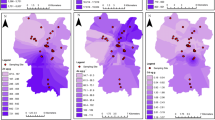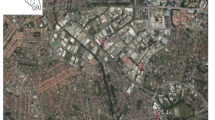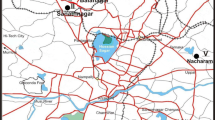Abstract
Due to rapid urbanization and industrialization, road dust enriched with heavy metals (HMs) emerges as a global problem as it poses a series of threats to the human health of all age groups. The present study investigates the concentration, contamination, spatial distribution, ecological and health risks associated with road dust HMs. Seventy road dust samples were collected for three different seasons (winter, summer, and monsoon) from Dehradun city, Uttarakhand, India. The road dust samples were subjected to acid digestion and rigorously analyzed through inductively coupled plasma-mass spectrometry (ICP-MS) to determine the concentrations of seven potentially toxic HMs, i.e. Zinc (Zn), Copper (Cu), Lead (Pb), Cadmium (Cd), Chromium (Cr), Nickel (Ni), and Arsenic (As). The average concentration of Zn, Cu, Pb, Cd, Cr, Ni, and As were 172.14, 59.64, 109.83, 1.80, 32.69, 23.29, and 2.72 mg-kg−1 respectively. The concentration of Zn, Cu, Pb, Cd, and As was found higher than the Indian natural soil background value and continental upper crust value. The principal component analysis shows that the HMs come from mixed sources such as Zn, Cu, Pb, and Ni mainly come from different traffic activities whereas Cd, Cr, and As mainly come from paint abrasion, fuel burning, and pesticides and fertilizers containing Cd and As compounds. The pollution index (PI) shows that Cd, Pb, Cu, and As come under the high contamination category. The spatial distribution of PI shows that the extent of pollution is highest in central, eastern, and northeastern zones as compared to other zones of the Dehradun city. Potential ecological risk results show that Cd accounts for 87.12% of the risk followed by Pb (5.32%) and Cu (3.43%). The health risk assessment showed that there is no non-carcinogenic risk of the studied HMs for children and adults. The ingestion pathway is turned out to be the major route of exposure for all the studied HMs calculated for carcinogenic and non-carcinogenic risk in children and adults followed by dermal contact and inhalation. The results also showed that children are more susceptible to HMs contamination in comparison to adults. The descending order of lifetime cancer risk (LCR) for four studied HMs is found as follows: Cd > NI > Cr > As for both children and adults. The LCR results reveal that the value of Cd, Cr, Ni, and As were greater than 1 × 10–6 for both age groups, indicating the possibility of cancer development in near future.





Similar content being viewed by others
References
Adamie E, Jarosz-Krzemińska E, Wieszała R (2016) Heavy metals from non-exhaust vehicle emissions in urban and motorway road dusts. Environ Monit Assess 188(6):1–11. https://doi.org/10.1007/s10661-016-5377-1
Adamiec E, Jarosz-Krzemińska E, Wieszała R (2016) Heavy metals from non-exhaust vehicle emissions in urban and motorway road dusts. Environ Monit Assess 188(6):1–1
Adimalla N, Wang H (2018) Distribution, contamination, and health risk assessment of heavy metals in surface soils from northern Telangana. India Arab J Geosci 11(21):1–5
Adimalla N (2019) Heavy metals contamination in urban surface soils of Medak province, India, and its risk assessment and spatial distribution. Environ Geochem Health 42:59–75. https://doi.org/10.1007/s10653-019-00270-1
Ahmad HR, Mehmood K, Sardar MF, Maqsood MA, Rehman MZ, Zhu C, Li H (2019) Integrated risk assessment of potentially toxic elements and particle pollution in urban road dust of megacity of Pakistan. Hum Eco Risk Assess 26(7):1810–1831. https://doi.org/10.1080/10807039.2019.1611415
Ali H, Khan E, Ilahi I (2019) Environmental chemistry and ecotoxicology of hazardous heavy metals: environmental persistence, toxicity, and bioaccumulation. J Chem. https://doi.org/10.1155/2019/6730305
Arora AS, Reddy AS (2013) Multivariate analysis for assessing the quality of stormwater from different Urban surfaces of the Patiala city, Punjab (India). Urban Water Journal 10(6):422–433. https://doi.org/10.1080/1573062X.2012.739629
Assad N, Sood A, Campen MJ, Zychowski KE (2018) Metal-induced pulmonary fibrosis. Curr Environ Health Rep 5(4):486–498. https://doi.org/10.1007/s40572-018-0219-7
Balali-Mood M, Naseri K, Tahergorabi Z, Khazdair MR, Sadeghi M (2021) Toxic mechanisms of five heavy metals: mercury, Lead, Chromium, Cadmium, and Arsenic. Front Pharmacol 12:643972. https://doi.org/10.3389/fphar.2021.643972
Bisht L, Gupta V, Singh A, Gautam AS, Gautam S (2022) Heavy metal concentration and its distribution analysis in urban road dust: a case study from most populated city of Indian state of Uttarakhand. Spat Spatiotemporal Epidemiol 40:100470. https://doi.org/10.1016/j.sste.2021.100470
Boskabady M, Marefati N, Farkhondeh T, Shakeri F, Farshbaf A, Boskabady MH (2018) The effect of environmental lead exposure on human health and the contribution of inflammatory mechanisms, a review. Environ Int 120:404–420. https://doi.org/10.1016/j.envint.2018.08.013
Chen P, Bi X, Zhang J, Wu J, Feng Y (2015) Assessment of heavy metal pollution characteristics and human health risk of exposure to ambient PM2.5 in Tianjin. China Particuol 20:104–109. https://doi.org/10.1016/J.PARTIC.2014.04.020
Darko G, Dodd M, Nkansah MA, Aduse-Poku Y, Ansah E, Wemegah DD, Borquaye LS (2017) Distribution and ecological risks of toxic metals in the topsoils in the Kumasi metropolis. Ghana Cogent Environ Sci 3(1):1354965. https://doi.org/10.1080/23311843.2017.1354965
Das S, Ting YP (2017) Evaluation of wet digestion methods for quantification of metal content in electronic scrap material. Resources 6(4):64. https://doi.org/10.3390/resources6040064
Delibašić Š, Đokić-Kahvedžić N, Karić M, Keskin I, Velispahić A, Huremović J, Pašalić A (2020) Health risk assessment of heavy metal contamination in street dust of federation of Bosnia and Herzegovina. Hum Ecol Risk Assess 27(5):1296–1308. https://doi.org/10.1080/10807039.2020.1826290
Duan Z, Wang J, Cai X, Wu Y, Xuan B (2020) Spatial distribution and human health risk assessment of heavy metals in campus dust: a case study of the university town of Huaxi. Hum Ecol Risk Assess 26(4):986–999. https://doi.org/10.1080/10807039.2018.1548900
Duggal V, Rani A (2018) Carcinogenic and noncarcinogenic risk assessment of metals in groundwater via ingestion and dermal absorption pathways for children and adults in Malwa Region of Punjab. J Geol Soc India 92:187–194. https://doi.org/10.1007/s12594-018-0980-0
Duncan AE, de Vries N, Nyarko KB (2018) Assessment of heavy metal pollution in the sediments of the River Pra and its tributaries. Water Air Soil Pollut 229:272. https://doi.org/10.1007/s11270-018-3899-6
Gautam S, Kumar P, Patra AK (2016) Occupational exposure to particulate matter in three Indian opencast mines. Air Qual Atmos Health 9(2):143–158
Gautam S, Patra AK, Kumar P (2019) Status and chemical characteristics of ambient PM2.5 pollutions in China: a review. Environ Sustain Develop 21(4):1649–1674. https://doi.org/10.1007/s10668-018-0123-1
Gautam S, Patra AK (2015) Dispersion of particulate matter generated at higher depths in opencast mines. Environ Technol Innov 3:11–27
Gautam S, Prusty BK, Patra AK (2015) Dispersion of respirable particles from the workplace in opencast iron ore mines. Environ Technol Innov 4:137–149
Gautam S, Tataliya A, Patel M, Chabhadiya K, Pathak P (2020) Personal exposure to air pollutants from winter season bonfires in rural areas of Gujarat, India. Exposure Health 12:89–97
Gollakota ARK, Gautam S, Santosh M, Sudan HA, Gandhi R, Jebadurai VS, Shu CM (2021) Bioaerosols: characterization, pathways, sampling strategies, and challenges to geo-environment and health. Gondwana Res 99:178–203. https://doi.org/10.1016/j.gr.2021.07.003
Gope M, Masto RE, George J, Balachandran S (2018) Tracing source, distribution and health risk of potentially harmful elements (PHEs) in street dust of Durgapur, India. Ecotoxicol Environ Saf 154:280–293. https://doi.org/10.1016/j.ecoenv.2018.02.042
Gowd SS, Reddy MR, Govil PK (2010) Assessment of heavy metal contamination in soils at Jajmau (Kanpur) and Unnao industrial areas of the Ganga Plain, Uttar Pradesh. India J Hazard Mater 174(1):113–121. https://doi.org/10.1016/j.jhazmat.2009.09.024
Gupta V, and Arya AK 2016 Demonstrating urban pollution using heavy metals in road dusts from Lucknow City, Uttar Pradesh, India. Environ Conserv 17(12):137–146. https://doi.org/10.36953/ECJ.2016.171215
Hakanson L 1980 An ecological risk index for aquatic pollution control.a sedimentological approach. Water Res.14(8): 975–1001. https://doi.org/10.1016/0043-1354(80)90143-8
Haris H, Looi LJ, Aris AZ, Mokhtar NF, Ayob NAA, Yusoff FM, Praveena SM (2017) Geo-accumulation index and contamination factors of heavy metals (Zn and Pb) in urban river sediment. Environ Geochem Health 39(6):1259–1271. https://doi.org/10.1007/s10653-017-9971-0
Hu W, Wang H, Dong L, Huang B, Borggaard OK, Hansen HCB, Holm PE (2018) Source identification of heavy metals in peri-urban agricultural soils of southeast China: an integrated approach. Environ Pollut 237:650–661. https://doi.org/10.1016/j.envpol.2018.02.070
Huang JH, Li F, Zeng GM et al (2016) Integrating hierarchical bioavailability and population distribution into potential eco-risk assessment of heavy metals in road dust: a case study in Xiandao District, Changsha city, China. Sci Total Environ 541:969–976
Humbal C, Gautam S et al (2019) Evaluating the colonization and distribution of fungal and bacterial bioaerosol in Rajkot, western India using multi-proxy approach. Air Qual Atmos Health 12(6):693–704
Humbal C, Gautam S, Trivedi U (2018) A review on recent progress in observations, and health effects of Bioaerosols. Environ Int 118:189–193
Idris AM, Alqahtani FM, Said TO, Fawy KF (2020) Contamination level and risk assessment of heavy metal deposited in street dusts in Khamees-Mushait city. Saudi Arabia Hum Eco Risk Assess 26(2):495–511. https://doi.org/10.1080/10807039.2018.1520596
International Agency for Research on Cancer. 1972. IARC monographs on the evaluation of carcinogenic risk of chemicals to man. IARC monographs on the evaluation of carcinogenic risk of chemicals to man., 1.
Jadoon WA, Khpalwak W, Chidya RC, Abdel-Dayem SM, Takeda K, Makhdoom MA, Sakugawa H (2018) Evaluation of levels, sources and health hazards of road-dust associated toxic metals in Jalalabad and Kabul Cities. Afghanistan Arch Environl Contam Toxicol 74(1):32–45. https://doi.org/10.1007/s00244-017-0475-9
Jahandari A (2020) Pollution status and human health risk assessments of selected heavy metals in urban dust of 16 cities in Iran. Environ Sci Pollut Res Int 27(18):23094–23107. https://doi.org/10.1007/s11356-020-08585-8
Jiang Y, Chao S, Liu J, Yang Y, Chen Y, Zhang A, Cao H (2017) Source apportionment and health risk assessment of heavy metals in soil for a township in Jiangsu Province, China. Chemosphere 168:1658–1668. https://doi.org/10.1016/j.chemosphere.2016.11.088
Jin Y, O’Connor D, Ok YS, Tsang DC, Liu A, Hou D (2019) Assessment of sources of heavy metals in soil and dust at children’s playgrounds in Beijing using GIS and multivariate statistical analysis. Environ Int 1(124):320–328. https://doi.org/10.1016/j.envint.2019.01.024
Kamani H, Mirzaei N, Ghaderpoori M, Bazrafshan E, Rezaei S, Mahvi AH (2018) Concentration and ecological risk of heavy metal in street dusts of Eslamshahr. Iran Hum Ecol Risk Assess 24(4):961–970. https://doi.org/10.1080/10807039.2017.1403282
Khan RK, Strand MA (2018) Road dust and its effect on human health: a literature review. Epidemiol Health 40:e2018013. https://doi.org/10.4178/epih.e2018013
Kuhad MS, Malik RS, Singh A, Dahiya IS (1989) Background levels of heavy metals in agricultural soils of Indogangetic plains of Haryana. J Indian Soc Soil Sci 37:700–705
Kusin FM, Azani NNM, Hasan SNMS, Sulong NA (2018) Distribution of heavy metals and metalloid in surface sediments of heavily-mined area for bauxite ore in Pengerang, Malaysia and associated risk assessment. CATENA 165:454–464. https://doi.org/10.1016/j.catena.2018.02.029
Li HY, Shi AB, Zhang XR (2015) Particle size distribution and characteristics of heavy metals in road-deposited sediments from Beijing Olympic Park. J Environ Sci 32:228–237
Li J, Wang G, Liu F, Cui L, Jiao Y (2021) Source apportionment and ecological-health risks assessment of heavy metals in topsoil near a factory, Central China. Expo Health 13:79–92. https://doi.org/10.1007/s12403-020-00363-8
Liao Y, Li D, Zhang N (2018) Comparison of interpolation models for estimating heavy metals in soils under various spatial characteristics and sampling methods. Trans GIS 22(2):409–434
Liu E, Yan T, Birch G, Zhu Y (2014) Pollution and health risk of potentially toxic metals in urban road dust in Nanjing, a mega-city of China. Sci Total Environ 476–477:522–531. https://doi.org/10.1016/j.scitotenv.2014.01.055
Liu P, Lei Y, Ren H, Gao J, Xu H, Shen Z, Pan H (2017) Seasonal variation and health risk assessment of heavy metals in PM25 during winter and summer over Xi’an China. Atmosphere 8(5):91. https://doi.org/10.3390/atmos8050091
Martínez-Castillo M, García-Montalvo EA, Arellano-Mendoza MG, Sánchez-Peña LDC, Soria Jasso, LE, Izquierdo-Vega JA, Valenzuela OL and Hernández-Zavala A. 2021. Arsenic exposure and non-carcinogenic health effects. Human Exp Toxicol, 40(12_suppl), S826-S850. https://doi.org/10.1177/09603271211045955
Masih J, Gautam S, Nair A, Singhal RK, Venkatesh M, Basu H, Dyavarchetty S, Uzgare A, Tiwari R, Taneja A (2019) Chemical characterization of sub-micron particles in indoor and outdoor air at two different microenvironments in the western part of India. SN Appl Sci 1:165. https://doi.org/10.1007/s42452-019-0164-6
Mathur R, Balaram V, Satyanarayanan M, Sawant SS (2016) Assessment of heavy metal contamination of road dusts from industrial areas of Hyderabad. India Environ Monit Assess 188(9):514. https://doi.org/10.1007/s10661-016-5496-8
Muller G (1969) Index of geoaccumulation in sediments of the Rhine River. GeoJournal 2:108–118
Nduka JK, Kelle HI, Amuka JO (2019) Health risk assessment of cadmium, chromium and nickel from car paint dust from used automobiles at auto-panel workshops in Nigeria. Toxicol Rep 6:449–456. https://doi.org/10.1016/j.toxrep.2019.05.007
Patel DK, Jain MK (2021) Contamination and health risk assessment of potentially harmful elements associated with roadside dust in Dhanbad India. Stoch Environ Res Risk Assess. https://doi.org/10.1007/s00477-021-02061-6
Praveena SM, Aris AZ (2018) Status, source identification, and health risks of potentially toxic element concentrations in road dust in a medium-sized city in a developing country. Environ Geochem Health 40(2):749–762. https://doi.org/10.1007/s10653-017-0021-8
Qiao P, Lei M, Yang S, Yang J, Guo G, Zhou X (2018) Comparing ordinary kriging and inverse distance weighting for soil as pollution in Beijing. Environ Sci Poll Res 25(16):15597–15608
Rajaram BS, Suryawanshi P, Bhanarkar AD, Rao CVC (2014) Heavy metals contamination in road dust in Delhi City. India Environ Earth Sci 72:3929–3938. https://doi.org/10.1007/s12665-014-3281-y
Ray RR (2016) Adverse hematological effects of hexavalent chromium: an overview. Interdiscip Toxicol 9(2):55. https://doi.org/10.1515/intox-2016-0007
Rehman A, Liu G, Yousaf B, Zia-ur-Rehman M, Ali MU, Rashid MS, Farooq MR, Javed Z (2020) Characterizing pollution indices and children health risk assessment of potentiall toxic metal(oid)s in school dust of Lahore. Pakistan Ecotoxicol Enviro Saf 190:110059. https://doi.org/10.1016/j.ecoenv.2019.110059
Rodrigues EG, Bellinger DC, Valeri L, Hasan MOSI, Quamruzzaman Q, Golam M, Mazumdar M (2016) Neurodevelopmental outcomes among 2-to 3-year-old children in Bangladesh with elevated blood lead and exposure to arsenic and manganese in drinking water. Environ Health 15(1):1–9. https://doi.org/10.1186/s12940-016-0127-y
Roy S, Gupta SK, Prakash J, Habib G, Baudh K, Nasr M (2019) Ecological and human health risk assessment of heavy metal contamination in road dust in the National Capital Territory ( NCT ) of Delhi. India Environ Sci Pollut Res 26:30413–30425. https://doi.org/10.1007/s11356-019-06216-5
Ryder CL, Highwood EJ, Walser A, Seibert P, Philipp A, Weinzierl B (2019) Coarse and giant particles are ubiquitous in Saharan dust export regions and are radiatively significant over the Sahara. Atmos Chem Phy 19(24):15353–15376
Sadeghdoust F, Ghanavati N, Nazarpour A, Babaenejad T, Watts MJ (2020) Hazard, ecological, and human health risk assessment of heavy metals in street dust in Dezful. Iran Arab J Geosci 13:881. https://doi.org/10.1007/s12517-020-05915-5
Suryawanshi PV, Rajaram BS, Bhanarkar AD, and Rao CV. 2016. Determining heavy metal contamination of road dust in Delhi, India. Atmosfera 29(3): 221–234. https://doi.org/10.20937/ATM.2016.29.03.04
Taiwo AM, Awomeso JA, Taiwo OT, Oremodu BD, Akintunde OO, Ojo NO, Arowolo TA (2017) Assessment of health risks associated with road dusts in major traffic hotspots in Abeokuta metropolis, Ogun state, southwestern Nigeria. Stoch Environ Res Risk Assess 31(2):431–447. https://doi.org/10.1007/s00477-016-1302-y
Taiwo AM, Michael JO, Gbadebo AM, Oladoyinbo FO (2019) Pollution and health risk assessment of road dust from Osogbo metropolis, Osun state. Southwestern Nigeria Hum Eco Risk Assess 26(5):1254–1269. https://doi.org/10.1080/10807039.2018.1563478
Terradellas E, Nickovic, S, and Zhang XY. 2015. Airborne dust: A Hazard to Human Health, Environment and Society. World Meteorological Organization. 1–10. https://public.wmo.int/en/resources/bulletin/airborne-dust-hazard-human-health-environment-and-society
Trojanowska M, Świetlik R (2019) Investigations of the chemical distribution of heavy metals in street dust and its impact on risk assessment for human health, case study of Radom (Poland). Hum Eco Risk Assess 26(7):1907–1926. https://doi.org/10.1080/10807039.2019.1619070
USEPA. 1996a. Soil screening guidance: technical background document. EPA/540/R-95/128. Office of Solid Waste and Emergency Response
USEPA. 1996b. Soil screening guidance: technical background document. EPA/540/R-95/128. Office of SolidWaste and Emergency Response
USEPA. 1997. Exposure factors handbook EPA/600/P-95/002F
USEPA. 2001. Baseline human health risk assessment. Vasquez Boulevard and I-70 superfund site Denver, Denver (Co)
Wan D, Han Z, Yang J, Yang G, Liu X (2016) Heavy metal pollution in settled dust associated with different urban functional areas in a heavily air-polluted city in North China. Int J Environ Res Public Health 13(11):1119. https://doi.org/10.3390/ijerph13111119
Wedephol KH (1995) The composition of the continental crust. Geochim Cosmochim Acta 59(7):1217–1232. https://doi.org/10.1016/0016-7037(95)00038-2
Xiao Q, Zong Y, Malik Z, Lu S (2020) Source identification and risk assessment of heavy metals in road dust of steel industrial city (Anshan), Liaoning. Northeast China Hum Eco Risk Assess 26(5):1359–1378. https://doi.org/10.1080/10807039.2019.1578946
Xu X, Lu X, Han X, Zhao N (2015) Ecological and health risk assessment of metal in resuspended particles of urban street dust from an industrial city in China. Curr Sci 108(1):72–79
YangY LH, Lou S (2015) Decadal trend and interannual variation of outflow of aerosols from East Asia: roles of variations in meteorological parameters and emissions. Atmos Environ 100:141–153. https://doi.org/10.1016/j.atmosenv.2014.11.004
Yu B, Lu X, Fan X, Fan P, Zuo L, Yang Y, Wang L (2021) Analyzing environmental risk, source and spatial distribution of potentially toxic elements in dust of residential area in Xi’an urban area. China Ecotoxicol Environ Saf 208:111679. https://doi.org/10.1016/j.ecoenv.2020.111679
Zeng F, Wei W, Li M, Huang R, Yang F, Duan Y (2015) Heavy metal contamination in rice-producing soils of Hunan province, China and potential health risks. Int J Environ Res Public Health 12(12):15584–15593. https://doi.org/10.3390/ijerph121215005
Zhang H, Mao Z, Huang K, Wang X, Cheng L, Zeng L, Zhou Y, Jing T (2019) Multiple exposure pathways and health risk assessment of heavy metal(loid)s for children living in fourth-tier cities in Hubei Province. Environ Int 129:517–524
Acknowledgements
The authors are thankful to the University Grant Commission, New Delhi for providing the fellowship through Hemwati Nandan Bahguna Garhwal University (A Central University), Srinagar Garhwal, Uttarakhand, India.
Author information
Authors and Affiliations
Corresponding authors
Additional information
Publisher's Note
Springer Nature remains neutral with regard to jurisdictional claims in published maps and institutional affiliations.
Rights and permissions
About this article
Cite this article
Gupta, V., Bisht, L., Deep, A. et al. Spatial distribution, pollution levels, and risk assessment of potentially toxic metals in road dust from major tourist city, Dehradun, Uttarakhand India. Stoch Environ Res Risk Assess 36, 3517–3533 (2022). https://doi.org/10.1007/s00477-022-02207-0
Accepted:
Published:
Issue Date:
DOI: https://doi.org/10.1007/s00477-022-02207-0




